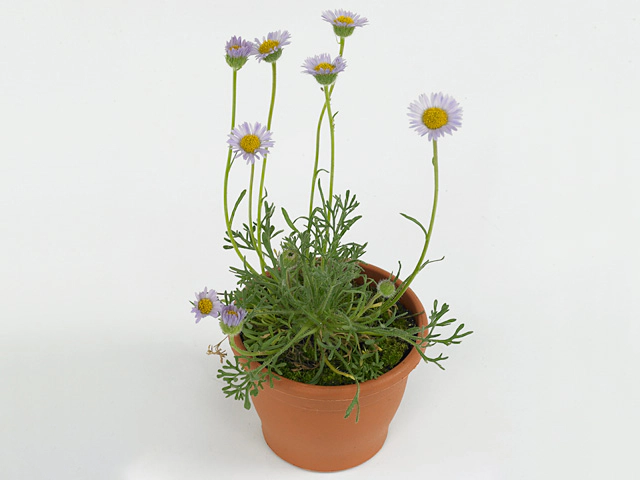Erigeron compositus

| Flower type | Single |
| Leaf margin | Lobed |
| Winter hardness | Good (USDA-zone 5, 6) |
| Flower color | Purple-light blue violet-085B |
| Soil fertility | Not very demanding |
| Flower diameter | 1 - 1,5 cm |
| Plant height | 10 - 20 cm |
| Inflorescence | Capitulum (head) |
| Flowering month(s) | March |
| Leaf width | 0 - 1 cm |
| Leaf surface | Hairy |
| Leaf size | 0 - 1 cm |
| Leaf, main color | Medium green; Dark green |
| Leaf colour, pattern | Unicolored |
| Soil type | Peaty |
Erigeron compositus, also known as the Cutleaf Fleabane, is a beautiful flower that belongs to the daisy family. This perennial plant is native to North America and is commonly found in regions with USDA hardiness zones 5 and 6. It is notorious for its single flowers with a diameter of 1 to 1.5 cm, which add a splash of color to any garden.
The flowers of Erigeron compositus are truly stunning, showcasing a unique purple-light blue-violet hue. Their delicate appearance and vibrant colors make them a popular choice among gardeners looking to add a touch of elegance to their landscapes. These flowers bloom in the month of March, bringing an early burst of color after the dull winter months.
One notable feature of Erigeron compositus is its lobed leaves. These leaves have a width of 0 to 1 cm and are covered in tiny hairs, giving them a hairy texture. The main color of the leaves varies from medium green to dark green, contributing to the overall visual appeal of the plant. The leaves are relatively small, measuring between 0 and 1 cm in size. They add a unique touch to the plant and perfectly complement the vibrant flowers.
The Cutleaf Fleabane is a relatively small plant, with a height ranging from 10 to 20 cm. This compact size makes it suitable for a variety of garden spaces, including flowerbeds, borders, and containers. Its low-growing habit and attractive foliage make it a great choice for rock gardens or as a ground cover in areas where larger plants may overpower the surroundings.
Erigeron compositus is adaptable to different types of soils, and while it prefers well-drained soil, it is not very demanding in terms of fertility. It can thrive in peaty soils, making it a versatile choice for various planting conditions. This characteristic makes it an excellent choice for gardeners who may not have access to nutrient-rich soil.
In terms of winter hardiness, Erigeron compositus is considered to be quite robust. It can withstand the cold temperatures of USDA hardiness zones 5 and 6, making it suitable for areas that experience freezing temperatures during the winter months. This winter hardiness makes it an ideal choice for gardeners in colder regions who want to enjoy the beauty of this plant year after year.
Overall, Erigeron compositus is a stunning flower with a unique color, lobed leaves, and a compact size. Its adaptability to different soil types, low maintenance requirements, and winter hardiness make it a desirable addition to any garden. Whether used as a border plant, ground cover, or in containers, this beautiful perennial is sure to bring joy and beauty to any landscape.
Market availability index by month:
| Jan. | Feb. | Mar. | Apr. | May | Jun. | Jul. | Aug. | Sep. | Oct. | Nov. | Dec. |
|---|---|---|---|---|---|---|---|---|---|---|---|
| - | - | - | - | 4 | 2 | - | - | - | - | - | - |